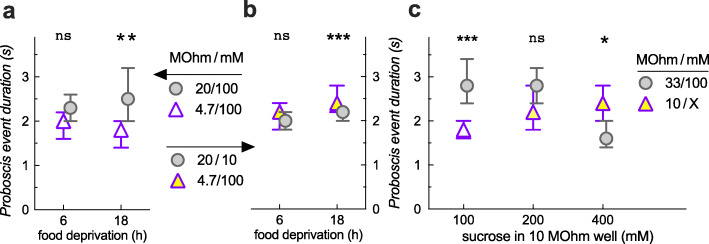Fig. 6.
Proboscis event duration changes with various parameters in a choice assay. a Event analysis from Fig. 5e, 15 min, reveals that proboscis event duration increases with food deprivation on the low-current well only (For this figure, medians with 95% confidence intervals are shown. For the analysis, the data were log-transformed to run 2-way ANOVAs, see the “Methods” section. Main effect of food well, p = 0.0006, but not of deprivation time, p = 0.41; event duration is no different between the high- vs. low-current well after 6-h food deprivation, p = 0.23, but longer on the low-current 20-MΩ well after 18 h, **p = 0.0016, Sidak’s multiple comparison test, n = 136, 75, 84, 116 events from 10 arenas per condition with 10 Canton-S males). b Analysis of Fig. 5f, 15 min, shows a main effect of well (p = 0.041), deprivation (p = 0.0012), and interaction (p = 0.029, n = 239, 209, 331, 368 events from 19 to 20 arenas). There is a slight, but highly significant increase in proboscis event duration on the higher current/higher sucrose well (***p < 0.0001) compared to the lower current/lower sucrose after 18 h of food deprivation. c Event analysis from Fig. 4c reveals a main effect of the well (p = 0.019), sucrose concentration (p = 0.028), and interaction (p < 0.001). With equal sucrose, flies had longer event durations on the lower current well (***p < 0.001), but they had longer proboscis event durations on the high-current well when paired with higher, 400 mM sucrose (*p = 0.015). Event duration increased significantly with sugar concentration on the high-current/variable-sucrose well (p = 0.006, linear regression), and it decreased significantly on the low-current/constant-sucrose well (p < 0.001; n = 164, 247, 139, 223, 165, 155 events from 7 to 8 arenas per condition, 10 Canton-S males)

